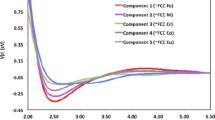Abstract
An original method of evaluation of the cluster population in carbon martensite has been developed. Using this method, it is shown that Kurdjumov’s model of carbon redistribution within the different octahedral site sublattices can quantitatively account for both observed normal and abnormal tetragonality in carbon martensite. It is also shown that the existence of the internal strains in martensite constitutes a necessary and sufficient condition for the energetic preference of tetrahedral over the cubic lattice. The presence of the residual tetragonal distortion in the quasi-cubic phase of k-martensite is associated with the presence of the mixed clusters formed of the atoms belonging to O c sublattice as well as to remaining ones. By using a computer simulation of the dynamical behavior of carbon martensite approaching the thermodynamical equilibrium, it was found that the ultimate state of this system is strongly beyond the thermal equilibrium. Even after long-term aging, the free energy is far beyond the minimum value allowed for this system. The reason for such a behavior and the possible aging processes proceeding in this system are discussed at the molecular level. All of the ordering parameters are affected by the aging process. The evolution proceeds in the distinctly different time intervals for different parameters. At first, the long-range ordering parameter that determines the tetragonality of martensite evolves and reaches the stable value. In the next stage, the formation and then disintegration of two-particle clusters occurs. Disintegration of two-particle clusters coincides with the stage when three-particle cluster formation occurs at a high rate. Threeparticle clusters also disintegrate when some time elapses. The same pattern repeats regarding four-, five-, six-, seven-, and eight-particle clusters. To simplify the calculations, the nine-particle clusters are assumed to be the largest possible and are identified with an existence of superstructure. The formation of 100 pct of nine-particle clusters with no contribution of free atoms in an alloy ceases all aging processes. The evolution of these processes is illustrated graphically in the time range from 16 seconds to 1500 years, as estimated on the basis of experimental data.
Similar content being viewed by others
References
J.M.R. Genin: Metall. Trans. A, 1987, vol. 18A, pp. 1371–88.
L. Dcabrowski: J. Mater. Sci., 1995, vol. 30, pp. 693–700.
L. Dcabrowski: J. Mater. Sci., 1990, vol. 25, pp. 2722–26.
G.V. Kurdjumov and A.A. Khachaturyan: Acta Metall., 1975 vol. 23, pp. 1077–88.
L. Dcabrowski: Phys. status solidi (b), 1985, vol. 128, pp. 371–78.
L.I. Lysak: Phys. Metall. Metallogr., 1978, vol. 45, pp. 94–106.
F.E. Fujita: Metall. Trans. A, 1977, vol. 8A, pp. 1727–36.
S. Kajiwara and T. Kikuchi: Acta Metall. Mater., 1991, vol. 39, pp. 1123–31.
G.V. Kudjumov and A.G. Khachaturyan: Metall. Trans., 1972, vol. 3, pp. 1069–76.
M. Hayakawa, M. Tanigami, and M. Oka: Metall. Trans. A, 1985, vol. 16A, pp. 1745–50.
Author information
Authors and Affiliations
Rights and permissions
About this article
Cite this article
Dabrowski, L. Clusters in carbon martensite: Thermodynamics and kinetics. Metall Mater Trans A 29, 2903–2912 (1998). https://doi.org/10.1007/s11661-998-0197-8
Received:
Issue Date:
DOI: https://doi.org/10.1007/s11661-998-0197-8




